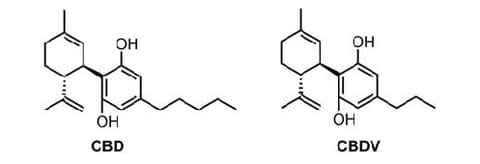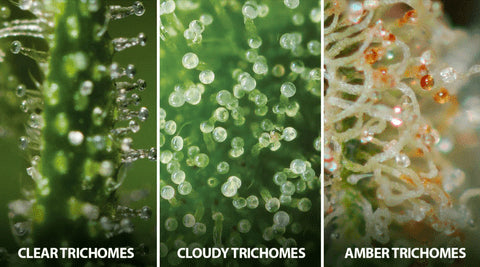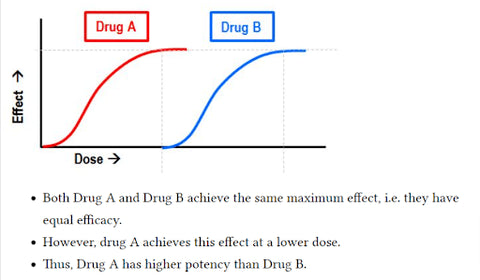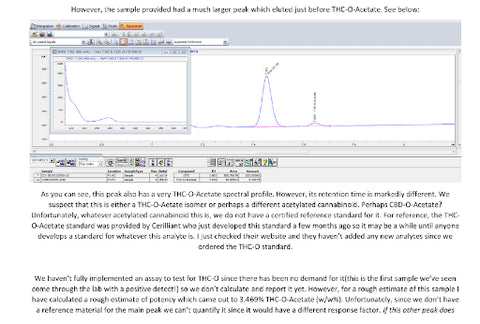Everything you need to know about CBDV
With countries worldwide slowly legalizing cannabis, research is finally growing and we’re constantly finding out more about the 120+ cannabinoids in the marijuana plant, namely CBDV, otherwise known as Cannabidivarin.
People are looking beyond conventional THC or CBD and seeking out new cannabinoids like this one, and in this article, we will explain why CBDV is worth looking into. The laws have limited public access and therapeutic research on non-psychoactive cannabinoids. Fortunately, we’re discovering more and more cannabinoids that are non-psychoactive and still have the healing properties of cannabis.
So, what is CBDV?
Cannabidivarin (CBDV) is a Varin cannabinoid first reported in a benzene extract from a Thai cannabis variety referred to as “Meao” in 1977, and identified for the first time in 1969 Vollner et al. CBDV is a homolog of CBD and is a non-psychoactive cannabinoid. As you can see below, The slight difference here is the propyl chain that CBDV carries.

Like CBD, cannabidivarin has 7 double bond isomers and 30 stereoisomers. There is a side-chain shortened by two methylene bridges. The biggest difference between CBD and CBDV is their concentrations in the cannabis plant. You can find trace amounts of CBDV in high-quality full-spectrum and broad-spectrum extracts that help to produce the entourage effect.
Varin cannabinoids (technically called varinolic cannabinoids) are a subfamily of cannabinoids that feature three carbons on their alkyl side chains. The most well-known examples are THCV, CBDV, CBGV, and CBCV. There are also acid forms of THCVA, CBDVA, CBGVA, and CBCVA.
CBDV exists in very small quantities. Recently, several African landrace strains (which are genetically pure and unimpacted by experimentation) of Cannabis indica were found to have CBDV and the related THCV in concentrations closer to 4%. There are also plant breeders creating high CBDV and THCV strains of hemp and marijuana — but the current record still sits below 7% CBDV.
What are the medicinal effects?
Epilepsy
Due to the rise in popularity of CBDV, researchers are trying to discover its medical benefits. In 2014, GW Pharmaceuticals finished a Phase 1 clinical trial of its CBDV test product (known as GWP42006). The clinical trial explored the use of CBDV as an anti-epileptic drug. The company continues to research CBDV heavily. You won’t feel a psychoactive ‘high’ from CBDV. Instead, you can expect it similar effects to CBD. The lack of a ‘high’ means we can use CBDV similarly, which is still being researched.
GW were set to enter Phase III trials in late 2019 but had to terminate the study because of the pandemic. They’re currently recruiting for a new trial, and the CEO Justin Gover made the following statement;
“CBDV represents an additional product pipeline opportunity as a next-generation epilepsy therapy.”
This study follows the completion of a Phase 1 trial in 66 healthy subjects in 2014. In this trial, CBDV was well tolerated even at the highest tested dose and no significant side effects were observed. Most importantly, following this trial, There were no serious or severe adverse events, nor any withdrawals due to adverse events.
Rett Syndrome
As you may know, Rett syndrome (RTT) is a rare neurodevelopmental disorder, characterized by severe behavioral and physiological symptoms with no cure available to date. A study was done on mice with CBDV being administered for 14 days. The study restored compromised general health status of the mice, the sociability, and the brain weight in RTT. While more studies are required, this shows great promise for the medical use of CBDV.
Autism
Some of the most interesting recent research into CBDV has been around the subject of autism. This condition, which affects more children and adults every year, is still being researched to find effective medications. The use of CBDV for autism has rapidly gained popularity over the last two years.
The study suggests that CBDV targets subcortical excitatory glutamate systems both in autistic and neurotypical adults. This study compared the effects of CBDV in neurodiverse patients and neurotypical patients. They noted a higher degree of difference in ASD patients with elevated glutamate. Very little benefit was reported on those with normal glutamate levels.
Some studies have even shown that people diagnosed with autism spectrum disorder (ASD) have below-average anandamide levels in the brain, one of the body’s endocannabinoids.
Pain
In this study, patients underwent two successive treatment phases (4 weeks each) and were treated with CBDV. While the study wasn’t necessarily conclusive, it did explore the potential utility of CBDV for neuropathic pain.
While CBDV research is increasing, so far there are no guarantees that cures or applications have been or will be found. The existing CBDV studies and research papers indicate grounds for medical optimism that previously may not have existed. With the growing interest in the industry, there’s endless potential. Fortunately, there should not be severe restrictions on CBDV, considering its lack of psycho-activity.
CBDV and the endocannabinoid system:
CBDV interacts with the endocannabinoid system (ECS) the same way as CBD. However, it’s thought to have about 25% of CBD potency. CBDV does not stimulate the ECS as CBD and THC do; it has a modulating action instead. According to the British Pharmacological Society;
“CBDV and all the acids inhibited DAGLα.”
DAGLα is an enzyme responsible for the synthesis of the endocannabinoid 2-AG.
Is CBDV Legal?
CBDV is legal in the United States, as long as it is produced from Hemp rather than marijuana. This is because CBDV derived from marijuana is illegal on a federal level and is considered a schedule 1 drug by the Drug Enforcement Agency (DEA). Some states have legalized marijuana for medicinal or recreational use. The states that have legalized marijuana have also legalized its derivatives, including CBDV.
CBDV derived from hemp containing no more than 0.3 percent THC is considered legal on a federal level due to the 2018 Farm Bill. This Bill gave states the power to further regulate hemp products, which some states have by restricting any traces of THC. Although hemp-derived CBDV is difficult to find, it’s legal in all states as long as it abides by the state THC regulations.
What is the difference between CBDV and CBD?
As previously mentioned, the molecular structures between CBD and CBDV are different, which impacts their chemical responses. Furthermore, CBDV can be used to develop THCV (tetrahydrocannabivarin) when it’s exposed to an acidic environment. CBD doesn’t have this same ability to transform into THC. When dealing with CBDV vs CBD, both cannabinoids share huge similarities that could be a massive hit in the medical industry because of the therapeutic effects offered. Above all, CBD and CBDV both interact with the endocannabinoid system, but CBDV binds with the cannabinoid receptors and CBD simply interacts or blocks the receptors.
Based on all the information provided, it’s clear why Cannabidivarin might be the next significant cannabinoid the world will witness, and we can only hope that research increases to increase the use of CBDV globally.














